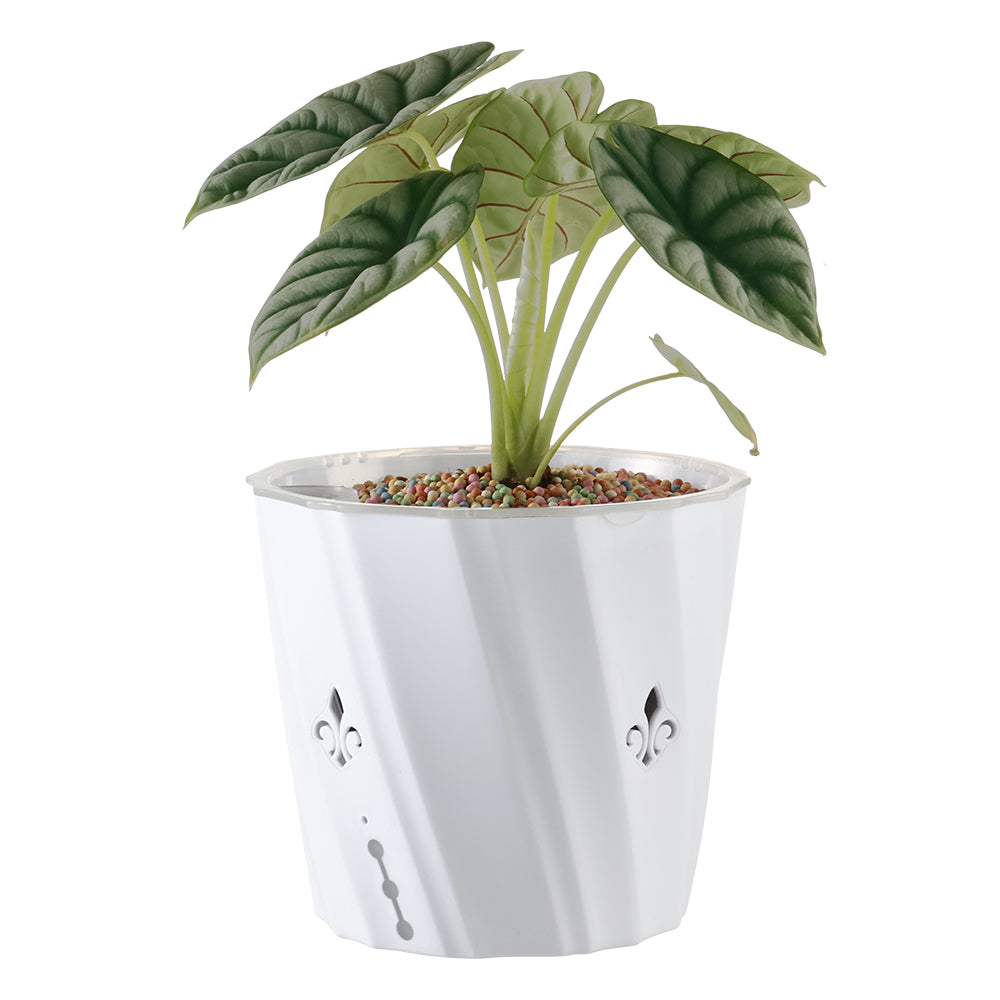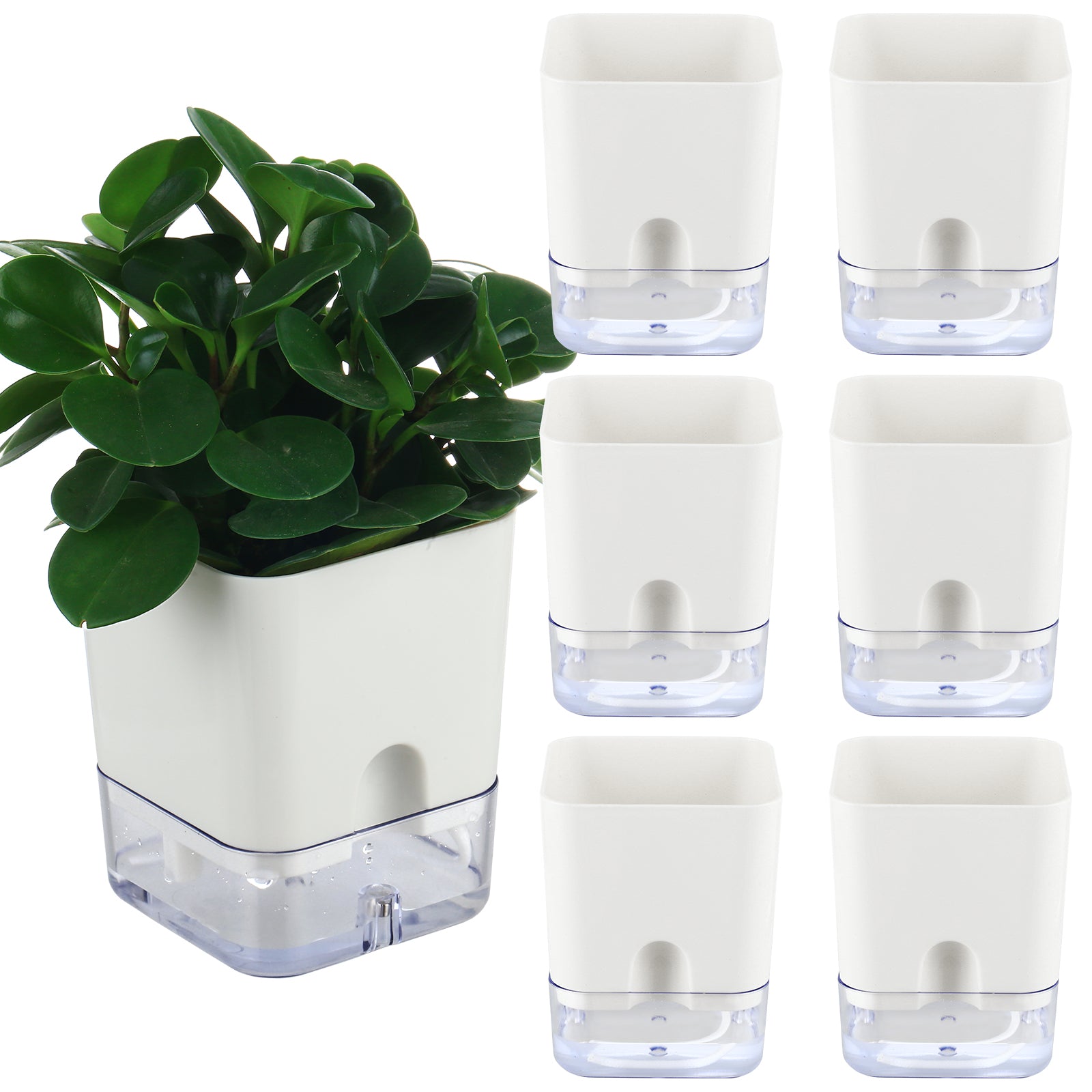Peace Lily Root Rot: Symptoms, Causes and Treatment
The peace lily is a fast-growing plant with creamy white flower. It is also known as "Spathiphyllum Wallisii" is an attractive plant that has been cultivated for centuries in Asian countries. Its roots tend to rot at the base making it difficult to move plants and slowing down its growth and beauty. In this article, we will briefly talk about Peace lily root rot, signs of root rot in peace lily, its treatment, and covering up all the confusion in your mind.
The peace lily is the kind of plant that is known to be one of the forgiving plants that can tolerate any kind of environmental situation but when it comes to root rot! They straight away pick up the white flag.
Self-watering planters can effectively help reduce the risk of root rot. Self-watering planters typically release water slowly and gradually, mimicking the natural watering cycle, which reduces the chances of overwatering and the subsequent root rot.
But here comes one question, how will you know your peace lily is facing root rot and how to treat it. Let's find out.
What is Root rot?
Root Rot is the name given to a fungi infection that lives in or on the roots of plants due to many issues including poor drainage system, overwatering, and wrong management of soil.
Learn how to identify root rot and how to prevent it in your home. This article includes tips for maintaining healthy roots. We also cover common causes of root rot and the most effective methods for prevention.
Read More
Jade Plant Root Rot: Causes, Symptoms, and Solutions
How to Treat Monstera Root Rot
Common Symptoms of Peace lily root rot
When the roots have started to rot, they can be easily spotted. Some of the common symptoms of peace lily root rot are:

Leaves start Wilting
Leaves get wet and don't get enough nutrients from the air, so they wilt. Overwatering is one of the main causes that can lead to wilt. Overwatering suffocates the plant and leads to the failure of the roots and they fail to supply nutrition to the plant.
Whenever you see droopy or wilted leaves, look for root rot.
Leaves turn yellow
In the autumn the leaves turn a yellow color. This is known to be the big reason for overwatering. When you see yellow leaves on your plants, immediately check the roots as they are trying to tell you that something is not right.
Stunted Growth
Root rot is the main reason for Stunted Growth. This usually happens if the roots have been exposed to wet soil, such as in poorly drained areas.
The most important thing for your peace lilies is to make sure that they have enough light and water (according to the need). If the soil is well-drained, your plants will be happier, and they’ll grow to their full potential.
The appearance of Black Spots
Black spots can't always be the initial signs of root rot in your peace lily. They can mean that your peace lily has been suffering or might face root rot in the past. Once the bacteria and pathogens cause damage to the fresh roots of the plant you'll notice black spots on the leaves of peace lily which are surrounded by a yellow hue.
The soil produces a Bad smell
You might smell a foul odor from the soil. If you get a foul smell, you can be sure that your peace lily is experiencing root rot. Root rot usually begins before you see yellow leaves or thin stems.
Causes of Root rot in Peace lily

There can be many different reasons for root rot in peace lily. Some of the most common reasons for root rot are:
Low Light
Peace lilies can survive low light but low light can slow their growth. When a plant is living in low light, it reduces the rate of photosynthesis and its metabolism due to which the soil takes longer to get dry. Soggy soil damages the roots and is the main reason for pests and fungi
All of these conditions are considered to be the main cause of root rot.
Overwatering
The peace lily is the type of plant that prefers slightly moist soil, but overwatering can cause its roots to rot. If you want a peace lily for your garden, make sure you water it frequently, but don't let it become wet.4
When we water peace lily regularly, it encourages it to grow smoothly. Overwatering, however, leads to root rot. The plant will not get enough oxygen to develop. This ultimately leads to the death of the root and eventually the entire plant.
Poor Drainage System
You may be watering your peace lilies properly, but when there are no proper holes in the pot and the extra water have no way to leave the soil from the holes. This extra water remains in the pot and will make the soil soggy making air stuck in the soil. Here is a great self water planter to avoid root rot due to the drainage system. Self watering modern pots has holes in the design to avoid root rot in peace lily.
All these conditions cause low-level oxygen and lead to root rot.
Large Pot Size
Many people consider growing a plant or a seedling in an oversized pot due to many reasons. However, the peace lily will hold more potting medium and, therefore, more water. This is the biggest problem for the peace lily root rot.
Peace Lily Root Rot Treatment

If you have a peace lily at your home and by reading the above symptoms you think that your peace lily is suffering from Root Rot! There are two possible ways to eliminate root rot from your plant.
- Repotting your Peace Lily in a new pot
- By using Self Watering Pots with Air holes
Repotting the plant
Repotting will provide a fresh, new, and dry environment that will help remove the fungus from the plant.
You should repot any damaged peace lily roots because they will hinder the plant's growth.
Here's how you can repot your peace lily and can get rid of the peace lily root rot:
- Hold the main stem of your peace lily and take it out of the pot gently.
- After your peace lily is out of the pot, wash away the soil with the light stream of water.
- Trim away the leaves and affected branches that are showing any signs of damage. Do this even if there are no problems to see because these cuts will give your plant a chance to recover by letting in more light and air.
- You can also use fungi spray on the infected roots or also can soak them in bleached water to remove all the bacteria from the roots.
- Now take the new dry pot and open its drainage holes. Must remember to put some of the pebbles at the bottom of the hole. This will keep the drainage holes clear so they don't get clogged.
- Fill one-third of the pot with fresh, well-draining potting soil.
- Now set the Peace Lily in the pot and gradually add fresh soil from all sides.
- The soil should be lightly moistened before planting the peace lily plant. Once it's repotted, place the peace lily in a spot where it gets at least six hours of full sunlight. Must remember, be careful of providing too much light during this period as it could lead to stress in the peace lily plant.
How to Prevent Root Rot In Peace Lily by Using Self Watering Pot?

You can also use this cute looking self-watering head pot with air holes that play a major role in minimizing the risk of root rot in peace lily. These are the pot that provides water directly to the roots of the plants and allows the plant to absorbs the water at its own pace. These self-watering plants are known to be the caretakers of the plant’s roots.
These self-watering pots basically work on a reservoir system. There is a storage tank of water at the bottom of the container. This helps the plant to get a consistent level of water moister from the soil that it requires.
Conclusion
Root rot can affect any type of plant because it is the base killer disease of plant and it can be fatal if you don’t take this on a serious note. Observe the growth of your peace lily and try to collect report of every week if possible.
Unfortunately, there is no turning back if your peace lily root system gets too rotten. The only choice in this case is to completely destroy the plant or condemn it.
FAQs
How to treat root rot in peace lily?
Trimming off all the affected roots and washing away all the soil on the roots that are affected can help in treating root rot in peace lily. Also, get rid of the soil when you think is fungus-infected and also sterilize it.
How to repot a peace lily with root rot?
You can easily repot a peace lily by following the steps below:
- Dispose of the soil inside the pot of the plant.
- Use the bleaching method to wash the pot.
- Dip the remaining roots of the plant inside the fungicide solution to kill the root rot fungus.
- Finally, add the potting soil and repot your peace lily plant.
How to save a peace lily from root rot?
Peace lily can be saved easily by the below points:
- Remove damaged foliage of your peace lily.
- Place your plant in bright light but not in direct sunlight.
- Place it under the room temperature of nearly 75 - 78 Fahrenheit.
- Pot size should be larger than the plant’s root ball
- Do not water more often as it causes it hard to breathe the plant
- Refine the soil of your pot after every 2 weeks.
We have also covered all the safety points to save your peace lily from drooping or root rotting and root bounding visit Peace lily Drooping
How to tell if peace lily has root rot?
Root rot is most common in plants like peace lily. The primary symptoms of root rot disease are leaves turning black or brown dead with margins in centers and spots. The spots will appear as wet and mushy if conditions are moist.
*Disclosure: This post may contain affiliate links. As an Amazon Associate I earn from qualifying purchases.





















My roots were healthy and because I didn’t completely take it apart to remove all the soil to grow in water the roots are turning brown. I’ve pulled them all apart today and lightly brushed all the soiled out and scrubbed off as much of the yucky dark brown growth off it. I have rinsed if not soaked them in diluted hydrogen peroxide…. now I’m waiting….
But
There is another 2x bulbs where the bulbs have dwindled to nil roots…
Help!
Going to try the suggestions.
My peace lily turning yellow and brown.in a week I reported twice
How to make a homemade fungicide at home for root rot? ? Baking soda?? Peroxide
I followed all these recommendations and it worked perfectly. I am so happy because it was my first plant I got once we bought our first home. Very grateful. Thank you!
Leave a comment